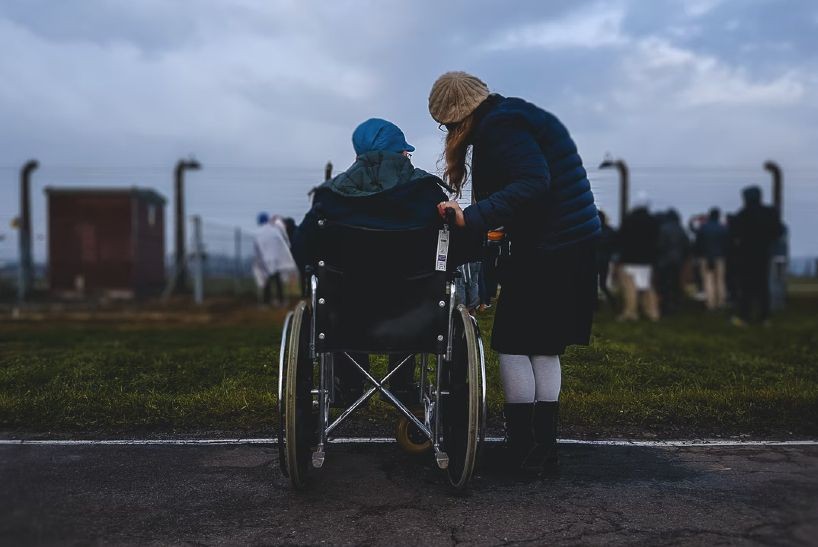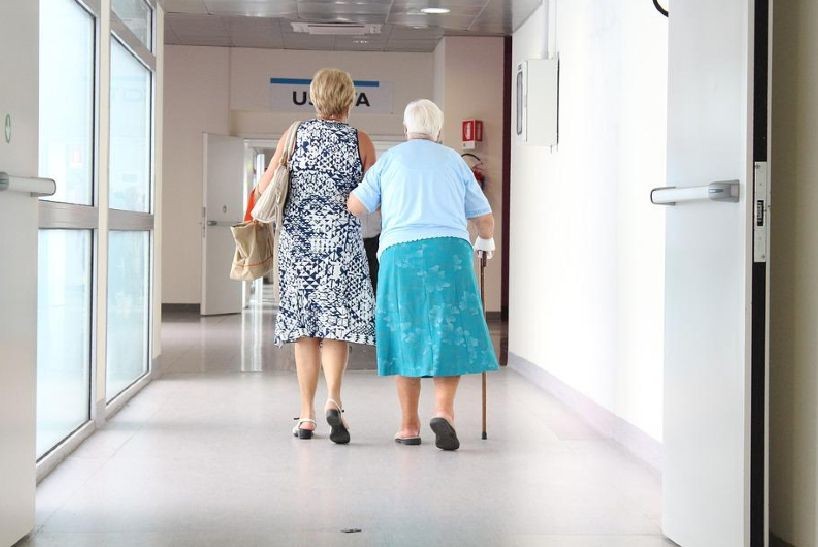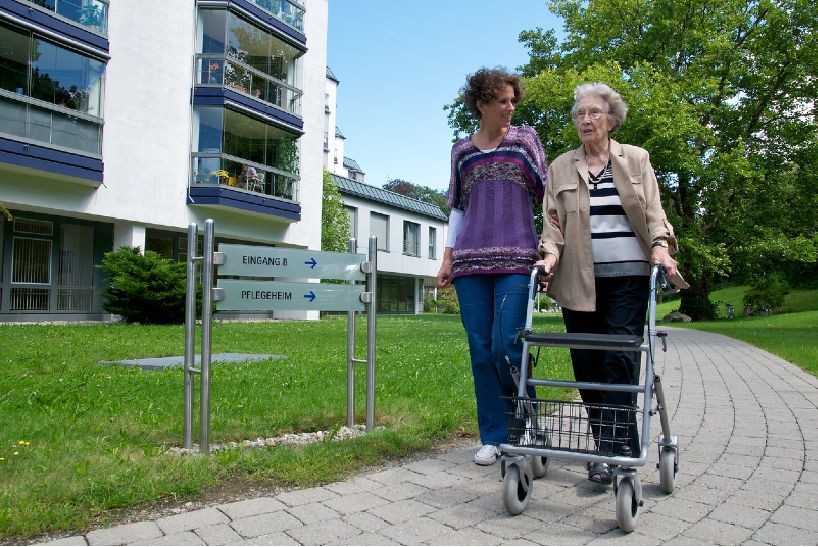Spitex vs. Assisted Living and Nursing Home
Specialist topics
Spitex vs. Assisted Living and Nursing Home
The older a person gets, the more their needs change. There may come a time when they can no longer cope with everyday life on their own. Then help from the family is worth its weight in gold. But at a certain point, this is no longer enough. Then there are various options, which we present to you in contrast to Spitex.

You are faced with an important decision: Which form of support is currently the right one for your relative? The first question that arises is whether he can still live alone in his familiar four walls. If the answer is yes, then Spitex care is an option.
How can Spitex be differentiated from other forms of support for the elderly?
Thanks to ever-advancing medical knowledge, people are getting older and staying mobile for longer and longer. It is therefore often not necessary to move to an inpatient facility. This is probably the biggest difference. Only the care provided by Spitex enables your relative to remain in their familiar home despite professional care.
This makes the situation much easier for him. Your relative can largely maintain their familiar routines and does not have to give up their home, which is full of memories and emotions. He only receives support when he really needs it. Otherwise, they remain largely independent.
Specialist Spitex staff can help them take their medication, care for wounds or measure their blood pressure, for example. Further assistance can be provided in the following areas, among others:
- Personal hygiene
- Measuring blood sugar levels
- Accompaniment to doctor's appointments
- Keeping the home tidy
Care in the nursing home

Nursing homes are inpatient facilities. Is your relative no longer able to cope with everyday life largely on their own? Does he need support almost around the clock? Then a care home offers a helping hand. Here, your relative will receive 24-hour medical supervision and comprehensive medical care.
Depending on the facility, single rooms as well as beds in shared rooms can be rented. It is only possible to take your own furniture with you to a limited extent, and in some cases not at all. However, a few personal items can be stored in the room if desired.
Your relative will follow a fixed daily routine in the care home. This makes it easier for them to settle into their new routine. In addition, there is no kitchen in the rooms, as self-catering is not planned.
In some cases, remaining in one's own home with the support of Spitex leads to isolation and loneliness. This does not happen in a care home, provided your relative is willing and able to socialize. Thanks to shared leisure activities in the inpatient facility, residents quickly get to talk to each other.
Numerous studies show just how important this togetherness is, even in old age. Almost one in three senior citizens in Switzerland sometimes or even often feels lonely. This has an impact on the psyche and can sometimes lead to depression. It is well known that mental suffering can also affect physical well-being, and psychosomatic complaints can occur.
What distinguishes assisted living from Spitex and nursing homes?

Assisted living represents a middle ground between care provided by Spitex and accommodation in a nursing home. People who are used to living a self-determined life are not always prepared to give it up.
However, according to surveys, around 40 percent of over 80-year-olds in Switzerland say that they would do just that on one condition. It must be a move to a more attractive housing option than their previous one. This means a combination of their own living space - ideally built to suit their age - and optimum medical care on demand. Assisted living fulfills these requirements.
Your relative moves in knowing that they have a very personal retreat just for themselves. This gives them a high degree of privacy, which is not available to the same extent in a nursing home. At the same time, he can rely on medical assistance at all times, but does not receive 24-hour monitoring.
What your relative can expect from assisted living
An assisted living apartment consists of one or more rooms and is usually barrier-free. The services provided, which your relative can make use of regularly or on call, are not just in the medical field.
They also provide relief in coping with everyday life. They will receive assistance with shopping, laundry, cleaning and more. They can also request a meal service. Despite having their own living space, social interaction is also provided. Joint excursions, games evenings and similar activities with other residents help your relative to socialize.
Moving into a care home often creates a feeling of being patronized. Assisted living gives your relative the opportunity to remain largely independent thanks to the barrier-free environment and on-demand support.
Assisted living is becoming increasingly important as a form of housing for older people who need support. It represents an important relief for nursing homes. It can accommodate anyone for whom the help of Spitex is not sufficient, but who does not require all the services of a nursing home.
However, the theory sounds easier than it actually is in practice. A decisive factor is the financial aspect, which is why we will take a closer look at this point below.
The financing problem in assisted living

The term "assisted living" has not yet been adequately defined. There are no legal regulations and there are major regional differences in terms of the scope of services. This is one of the reasons why there is currently no state support in terms of funding. People who live in sheltered housing pay any costs incurred out of their own pocket.
Your relative will have to pay for rent, medical, care and housekeeping services provided by third parties, as well as support in coping with everyday life. Only the health insurance company may offer support if care services are used that are provided by Spitex staff.
However, as assisted living can provide enormous relief for nursing homes, there are numerous efforts to provide further assistance. Ultimately, this relief can only be achieved if more Swiss people can afford assisted living. For example, the motion "Supplementary benefits for assisted living" aims to obtain funding via supplementary benefits (EL).
The supplementary benefits are used when the pension and other income are not sufficient to cover the minimum cost of living. In most cases, however, the funding provided under current legislation is not sufficient to cover the costs of assisted living. As a result, many senior citizens are forced to choose to live in a care home, the financing of which we will discuss below.
Around one in three nursing home residents does not require 24-hour care. Financial support from the public purse for assisted living could therefore save numerous care places.
This is the situation regarding the costs of care home accommodation
We have already touched on this briefly: Living in a care home is generally much cheaper than assisted living. Various cost units take over the financing of care services. The local authority and the health insurance fund will work hand in hand with your relative if a care place is chosen.
The public sector and the health insurance fund co-finance inpatient care services. The extent to which this happens depends on the care level or care requirement. Level 1, for example, corresponds to a need of up to 20 minutes per day. The health insurance company contributes CHF 9.60 to the costs incurred. For the other care levels, the financing is as follows:
- Care level 2: CHF 19.20
- Care level 3: CHF 28.80
- Care level 4: CHF 38.40
- Care level 5: CHF 48
- Care level 6: 57.60 CHF
- Care level 7: 67.20 CHF
- Care level 8: CHF 76.80
- Care level 9: CHF 86.40
- Care level 10: 96 CHF
- Care level 11: 105.60 CHF
- Care level 12: CHF 115.20
Your relative will contribute to the remaining costs with their annual deductible, the excess and a patient contribution. This varies from canton to canton, but amounts to a maximum of CHF 21.60 per day. Any remaining amount for care services is covered by the public purse.
Your relative will be fully responsible for the costs of non-nursing services such as meals and laundry. If they have taken out supplementary long-term care insurance, they will receive support from this.
Your relative will only receive financial assistance from the state if they are unable to cover their minimum living costs themselves. In this case, he is entitled to supplementary benefits. It is also possible to receive a helplessness allowance if they are dependent on the help of third parties to carry out everyday tasks.
How your relative covers the costs of Spitex

Does your relative only need support in certain areas of life and decide to use Spitex? Then he or she will cover the costs together with the health insurance company. The KVG requires a needs assessment to be carried out. The Spitex specialist will determine which services your relative urgently needs in order to ensure their physical and mental well-being.
The doctor will then review the assessment and make any necessary changes. If the needs assessment is correct, the doctor forwards the document to the health insurance company. As a rule, the insurance company will then cover 90 percent of the costs of all services listed in the document.
The remaining ten percent will be financed by your relative up to a total of CHF 700. If he wishes to make use of further services, he will pay for them in full himself. He also pays the aforementioned annual deductible and an excess.
As with nursing homes, the co-payment for Spitex services also depends on the canton. The maximum daily amount is CHF 15.95. If your relative is unable to cover the costs, they may receive support from supplementary or disability insurance. This may, for example, contribute to the financing of housekeeping services.
As with the nursing home, your relative can also receive support for Spitex services from the supplementary or disability insurance or a helplessness allowance. Of course, this is only the case if they meet the above-mentioned requirements.
Find the right Spitex with just a few clicks
Has your relative opted for Spitex or a residential or nursing home? Then we at OPAN® can help you find a suitable organization. All you have to do in the first step is enter your relative's zip code and start the search.
All the organizations in the area will then appear and you can select the one that suits you best. Registration requires you to enter the name of your relative, their health insurance company and the doctor treating them.
We at OPAN® transfer your details immediately, even if the business hours of the chosen organization are already over. In this way, we ensure that your application is processed as quickly as possible. Your contact at Spitex or the residential or nursing home will be in touch within a few days. Feel free to contact us if you have any questions or need assistance with your registration!
